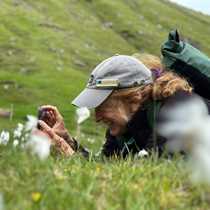At the Confluence of the Snake and Clearwater Rivers
Even though the option of two different excursions split our destinations today, the date on the calendar bound us together with the The Corps of Volunteers for the Northwest Discovery. Numerous are the claims to the official starting point of the Lewis and Clark Expedition. Geographically, monetarily, conceptually – all “starting points” are debated and most likely will be as long as there are two people willing and able to orate and gesticulate. May 14, 1804, today’s day plus 200 years later, is the date for the first journal entry from William Clark as he “proceeded on under a jentle brease up the Missouri” to wait for Meriwether Lewis.
The Expedition knew from the beginning that they would not be able to carry all the food they would need for their journey. With this in mind, some of the expedition members were chosen for their hunting skills, but what about the vegetables? Meriwether Lewis knew a vast number of eastern plant species, but he wasn’t sure of the edibility of many of these new western species of roots and bulbs. The definition of “edible” does not necessarily mean the consumer will enjoy dining on them, or that it will be a quiet digestion, as they discovered with the camas root.
The springtime landscape of the Clearwater River Valley and the surrounding prairies are splashed with colorful blossoms of edible roots and bulbs including wild onions, camas lilies and cous, a member of the parsley family. These were important staple foods for the native peoples. The members of the expedition traded items from glass beads to brass buttons for these tuberous morsels. On the return trip in 1806, trade goods were scarce, so why didn’t they dig their own roots? Growing in these same prairies and valleys are plants such as death camas and water hemlock. At a casual glance they may look very much like their edible relatives, to the experienced and trained eye, they are the difference between life and death.
The photograph above is of a member of the parsley family, like the cous and water hemlock. This plant could be a delicious accompaniment to your meal, or it could be your last meal depending on your skills of botanical identification – food for thought.
Even though the option of two different excursions split our destinations today, the date on the calendar bound us together with the The Corps of Volunteers for the Northwest Discovery. Numerous are the claims to the official starting point of the Lewis and Clark Expedition. Geographically, monetarily, conceptually – all “starting points” are debated and most likely will be as long as there are two people willing and able to orate and gesticulate. May 14, 1804, today’s day plus 200 years later, is the date for the first journal entry from William Clark as he “proceeded on under a jentle brease up the Missouri” to wait for Meriwether Lewis.
The Expedition knew from the beginning that they would not be able to carry all the food they would need for their journey. With this in mind, some of the expedition members were chosen for their hunting skills, but what about the vegetables? Meriwether Lewis knew a vast number of eastern plant species, but he wasn’t sure of the edibility of many of these new western species of roots and bulbs. The definition of “edible” does not necessarily mean the consumer will enjoy dining on them, or that it will be a quiet digestion, as they discovered with the camas root.
The springtime landscape of the Clearwater River Valley and the surrounding prairies are splashed with colorful blossoms of edible roots and bulbs including wild onions, camas lilies and cous, a member of the parsley family. These were important staple foods for the native peoples. The members of the expedition traded items from glass beads to brass buttons for these tuberous morsels. On the return trip in 1806, trade goods were scarce, so why didn’t they dig their own roots? Growing in these same prairies and valleys are plants such as death camas and water hemlock. At a casual glance they may look very much like their edible relatives, to the experienced and trained eye, they are the difference between life and death.
The photograph above is of a member of the parsley family, like the cous and water hemlock. This plant could be a delicious accompaniment to your meal, or it could be your last meal depending on your skills of botanical identification – food for thought.




